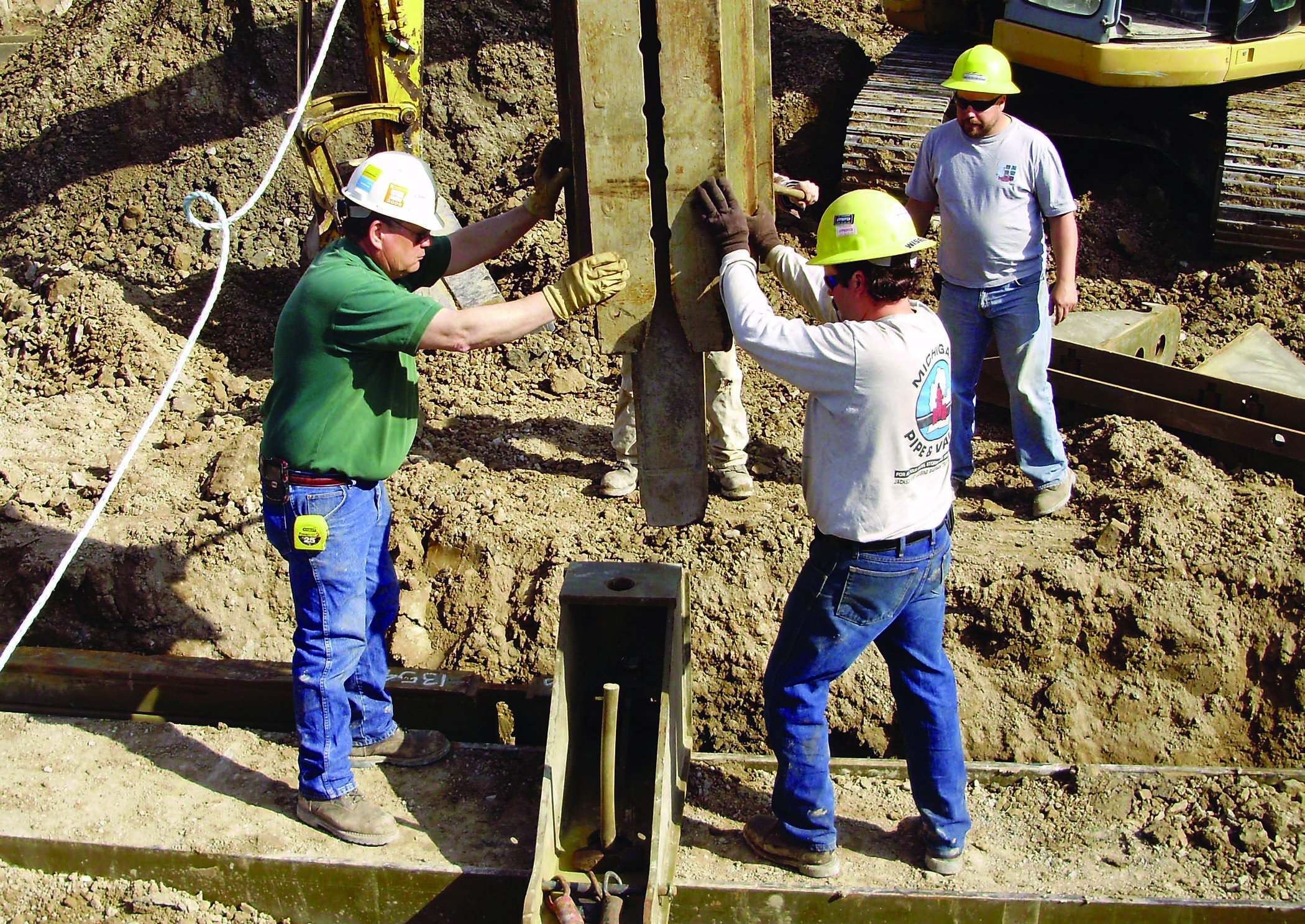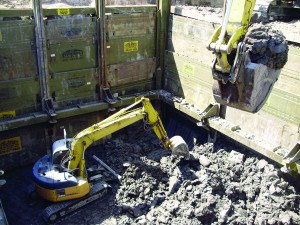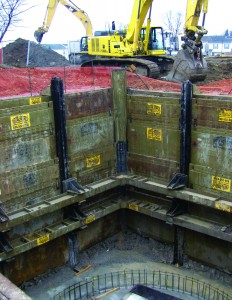August 2011, Vol. 66 No. 8
Features
Michigan Contractor Tackles New, Challenging Excavation Project

Theodore Roosevelt aptly said, “When you are asked if you can do a job, tell ’em, ‘Certainly I can!’ Then get busy and find out how to do it.” This is certainly the philosophy taken by contractor Tri-City Groundbreakers when they were low bidder on a deep excavation project that was larger and deeper than anything that they had attempted before.
Tri-City, headquartered in Midland, MI, cast in place a 24- by 26-foot lift station 40 feet deep for the city of Bay City’s Hampton Township Pump Station #1.
“Hampton Township was definitely our biggest undertaking, size-wise, up till then,” said Tri-City President John Schmidt. “We’d never gone that deep before, but we decided to go ahead and bid on it.”
Installing an underground structure can pose many excavation challenges, including soil conditions, site encumbrances and shoring the excavation for an extended period of time. All these factors came into play at the Hampton Township location.
“It was a postage stamp lot,” said John Briggs, Tri-City’s project manager on the project. “There were railroad tracks adjacent on one side, the dig was within a few feet of a residential street and there were other underground utilities running all around it.”
The biggest up front challenge was finding shoring that would work for the large and deep excavation. “We looked at the cost of sheet piling, and compared that with a couple of manufacturer’s slide rail systems,” said Schmidt. “We decided to go with a system from Efficiency Production.”
Based in Mason, MI; Efficiency Production Inc. is a leading manufacturer of Slide Rail Systems and other trench shoring equipment.
Efficiency’s Universal Slide Rail is a component shoring system comprised of steel panels (similar to trench shield sidewalls) and vertical steel posts. The versatile system can be used in a variety of configurations. In addition to the obstruction-free ClearSpan configuration, the system can be configured into small four-sided pits; or in a Multi-Bay configuration to install large tanks and structures; or lengths of pipe over 40 feet.

“When we got the quote on the system, there was a bit of sticker shock,” admits Schmidt. “But after factoring in the cost of sheeting, hiring a sheet piling crew, and the length of time it would take to install sheeting; slide rail then became a very economical and competitive alternative.”
System
Slide rail is installed simultaneously as the trench or pit is excavated. The individual component pieces can be handled with a standard size excavator which means that excavation contractors can usually install the shoring system themselves. Tri-City used a Komatsu PC 600 and CAT 330 to install the system. Inside the pit, Tri-City used a Komatsu PC 128 to dig under the posts and panels and any spots the bigger machines could not reach.
Slide rail is installed by sliding the panels into integrated rails on the posts, and then pushing the panels and posts incrementally down to grade as the pit is dug; a process commonly referred to as a “dig and push” shoring system. Slide rail is considered “active shoring” which means that personnel and equipment can be safely in the hole throughout the entire installation and removal process.
“Because we had never used slide rail before and this was the first time we had attempted an excavation of this size, there was a big learning curve for us,” admits Schmidt.
Briggs agreed. “It took a lot longer to install than we anticipated, but once we started going, it went in really easily.”

Due to Tri-City’s inexperience with a slide rail system, a senior team of Efficiency’s slide rail installers were onsite. “That’s very typical with first time slide rail users,” says Greg Ross, Efficiency’s director of slide rail systems. “The first day, they (contractor crew) usually are intrigued on how and if it’s going to work; the second day, there is usually a bit of consternation as they have to overcome unexpected ground conditions and as they are trying to put the system in one piece at a time; but by the third day, they really get the hang of it and start to figure out that this is a great system.”
After pre-cutting the site down about five to 7 feet, Tri-City installed a 38 by 50 by 32-foot deep ClearSpan configured slide rail system. ClearSpan’s design is unique in that it shores a large excavation without any need for cross-braces. The system stays entirely open by utilizing innovative waler I-beams on the outside of the system at the top, and inside the system to prevent deflection. The walers integrate into the Slide Rail system with the use of custom brackets that slide along the posts. The inside waler brackets have rollers on the back allowing it to easily move up and down as the system is installed and removed.
“We learned a lot of new things on the Hampton Road project, not the least of which is that a slide rail is an awesome system,” explained Schmidt. “It worked so well, we’ve used it on two other projects since then.”
In March 2011, Tri-City installed another large cast-in-place wet-well for the city of Saginaw’s McCarty Road Lift Station project. The round wet-well was 25-feet in diameter and 38-feet tall. It was installed in another ClearSpan Slide Rail System that was 40 by 40 by 32-feet deep. At the same time that the large wet well was being poured, Tri-City completed a tap on a chilled water line at Central Michigan University. Tri-City made the tap inside a 20 by 20 by 20-foot, four sided slide rail system.
Tri-City Groundbreakers provide many services for the commercial and industrial market. For more information on this family-owned business, visit
FOR MORE INFO:
Tri-City Groundbreakers, (989) 689-3474, www.tricitygroundbreakers.com
Efficiency Productions Inc., 800-552-8800, www.efficiencyproduction.com




Comments